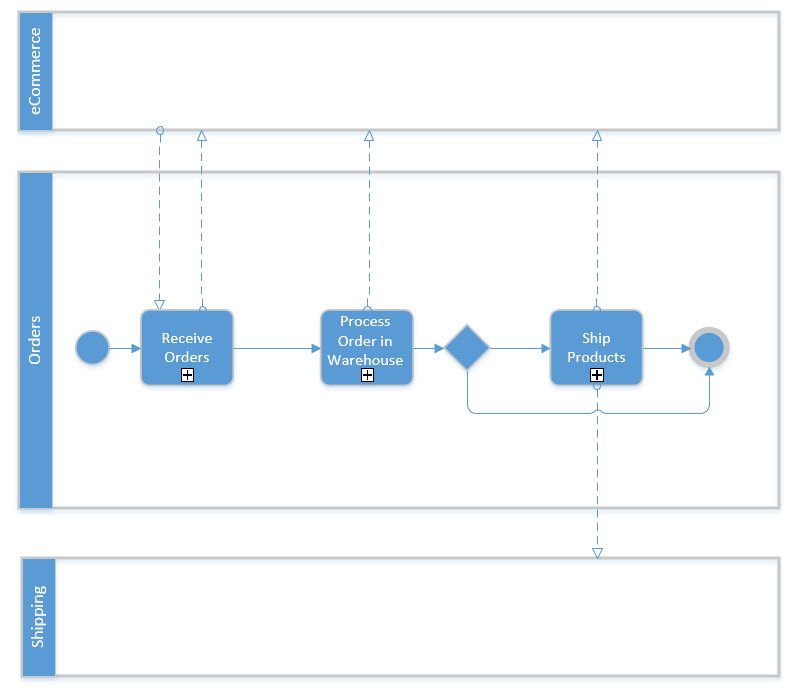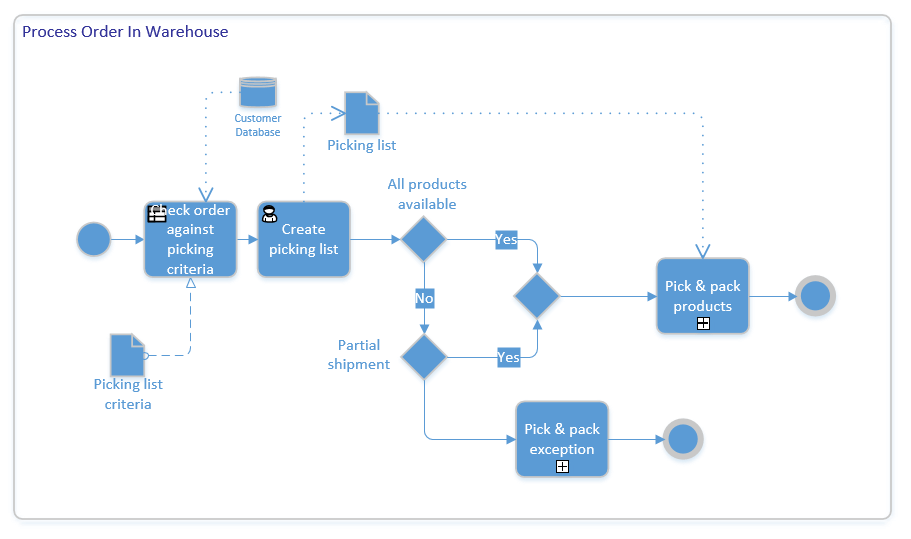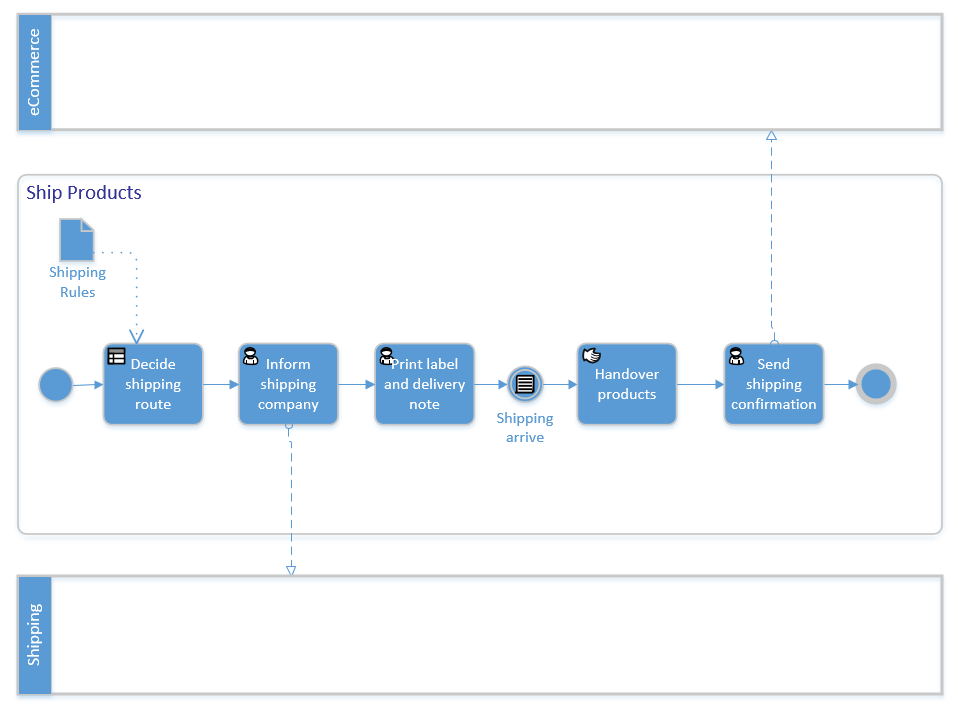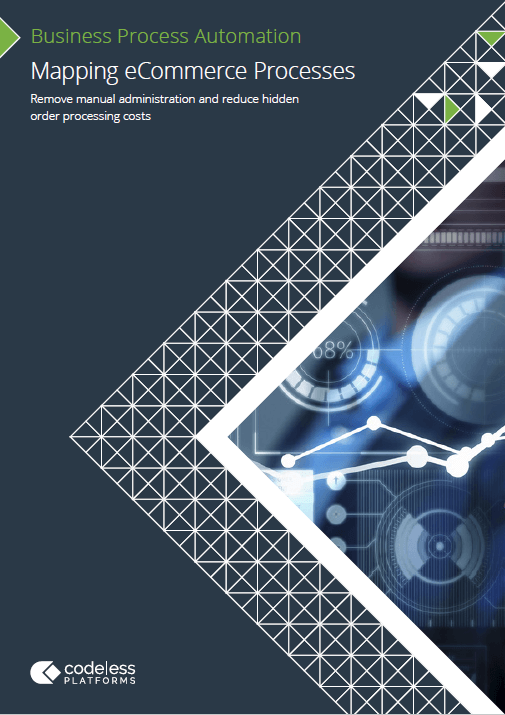What is an eCommerce process flow?
An eCommerce process flow can often be an area of online retail that is overlooked. In order to maximise sales opportunities and stay cost competitive, mapping out your eCommerce processes can help your business highlight key areas that may require automation or modification, and ultimately, improve performance.
The following article will help you to produce an eCommerce process flow that is unique to the way your business operates. An additional mapping eCommerce processes workbook is also available for you to use as a starting point to model your own processes and outlines an automated eCommerce process flow.
Key areas of a typical eCommerce process flow include:
- Receiving orders from your eCommerce system
- Processing order information
- Shipping
Top-Level eCommerce Process Flow
Unless you are already automating your eCommerce processes, managing eCommerce orders is a manual process. Employees have to log in and out of different business systems and databases, which is both time-consuming and prone to errors.
Each top-level process highlighted below holds a number of additional subprocesses (+). For example, when a sales order hits your back office operations employees have to manually process the information into your business software. This can result in administration errors and create process bottlenecks further down the line. In an automated process employee intensive administration tasks are removed.

Diagram: Overview of a typical eCommerce process flow
At the top level of an eCommerce process flow, the following can be easily identified:
- Customer places an order in your eCommerce system
- Order details are extracted from your eCommerce system and entered into your business software
- Order is passed to the warehouse to be processed
- Order is placed for fulfilment
Subprocess: Receiving Orders
When a customer places an order within your eCommerce system the order details need to be extracted and placed into your business software. Manually dealing with information held within a sales order can detract from the businesses planned objectives. Data entry errors can surface, employee efficiency is reduced and order processing costs increase.
The process of receiving the order is mapped below.

Diagram: Receiving orders from an eCommerce system and placing into business software
- Sales order details are manually extracted from your eCommerce system. Information includes customer information, description and ID of product ordered, payment details and transaction ID
- Employee manually checks sales order data for a correlation with your business rules e.g. full address, contact details, products ordered
- Employee manually enters order and customer details into your business software
- Employee manually creates and sends an order received notification to the customer
- If an employee identifies any anomalies they will need to contact the customer to resolve the issue
- If an issue cannot be resolved the employee may have to manually cancel the order
- Order is passed to warehouse for processing
How automation can help this process:
By automating this process the employee is removed from the scenario. If required, orders can be pulled on a timed or scheduled basis e.g. every 15 minutes. Orders are automatically entered into your business software and the customer receives and automated order confirmation notification. For a detailed overview of automated eCommerce processes,download the workbook.
Subprocess: Processing an Order in the Warehouse
Once an order has been checked and processed in your business software, the order is passed onto the warehouse for processing. Here, employees will have to manually check the order against your pick list business rules (stock availability, item location etc.) and create and print a pick list.

Diagram: Processing orders in the warehouse
- Employee notifies warehouse of an order that needs to be processed
- Employee manually checks the order against pick list criteria e.g. stock availability, item location in warehouse etc.
- Employee creates and prints pick list
- If products are in stock and available, the order is picked and packed
- Order is now ready for the shipping process
How automation can help this process:
An automated process will reduce employee time in cross-referencing your business software for stock availability and product location. It will dynamically automate the creation and printing of your pick lists. For a detailed overview of automated eCommerce processes,download the workbook.
Subprocess: Processing an Order for Shipping
Once an order has been processed in the warehouse it is now ready to be passed to shipping for fulfilment with a courier. Here, your business rules will determine which shipping route the employee chooses. Package data, such as weight, size, destination and costs, needs to be obtained. An employee will also need to manually print the shipping labels and contact the courier for fulfilment.

Diagram: Shipping products for fulfilment
- Employee enters package data, such as weight, size and destination into your courier provider system
- Employee prints shipping labels and delivery notes
- Shipping confirmation sent to customer
- Employee may or may not update your business software with tracking numbers
- Order handed over to courier for fulfilment
How automation can help this process:
An automated fulfilment process will remove the manual administration in this process as all package data and courier details will be in your business software. Your business systems will be integrated with your courier service providers solution, enabling them to ‘talk to each other’. An automated process will also provide you with the ability to automatically print shipping labels. The customer will receive an automated ‘dispatched’ notification, and tracking details will automatically synchronise with your business software. For a detailed overview of automated eCommerce processes,download the workbook.
Workbook: Mapping your eCommerce Process Flow
Mapping your eCommerce process flow provides you with a clear overview of where your processes start and end. It will make it easier for you to identify gaps within your process models and highlight areas where your business could benefit from automation or improvement.
In this article we have touched on the key areas within a typical eCommerce process flow. To help you model your own eCommerce process model we have created a workbook that details an automated eCommerce process flow. This workbook can be used as a starting point to map your eCommerce process and to help you identify areas where your business can improve its processes.
The workbook includes:
- Top-level eCommerce process flow
- Subprocess model: Automating the retrieval of sales orders and automatically placing them into your business software
- Subprocess model: Automating the processing of sales orders in the warehouse
- Subprocess model: Automating the placement of sales orders with courier services for shipping
- Notes for you to map and modify your process models
- Process automation and data integration recommendations and considerations
Automating your eCommerce Process Flow Next Steps
Automating your eCommerce processes provides you with the opportunity to automatically capture, track and ship customer sales orders. BPA Platform’s customisable integration and automation capabilities enable you to automate the delivery of eCommerce activity between your web shop, courier service and your in-house business software.
For more information on how to model or automate your eCommerce processes, download the workbook below or call us on +44 (0)330 99 88 700.

